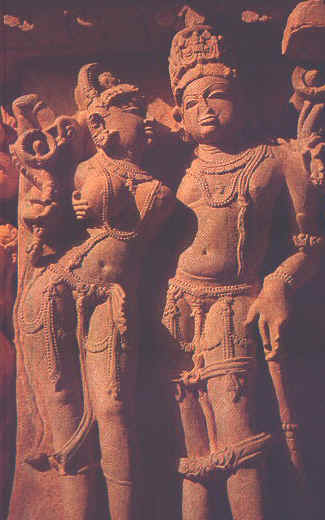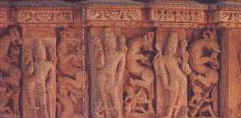Khajuraho in Madhya Pradesh is a well visited tourist
center. This village houses several temples from the 9th through the 13th centuries, built
in the Indo Aryan Nagara style of architecture, embellished with a
profusion of sculptural work. Around the temples are bands of fine work, depicting
several aspects of life, over a 1000 years ago, portraying gods, goddesses, musicians,
animals, etc. Erotic sculptures featuring Apsaras and mithunas
(couples) also dominate the themes portrayed here.

Khajuraho is virtually in the middle of nowhere.
Fortunately it is served by air from major cities. It is a a distance of 280
km from Gwalior, and 175 km from Jhansi and 120 km from Satna,
all three being major railheads.
History: Khajuraho was the historic
capital of the Chandellas, who ruled over this area from the 9th through
the 13th centuries. It was known as Kharjuravahaka. Tradition has it that
the city gates were ornamented with two golden Kharjura or date palm
trees. It is also believed that the name was derived from the numerous date palm trees
that thrived in the vicinity.
The Chandellas trace their origin to
the mythical sage Chandratreya born of the moon. The Chandella dynasty
came into being after the break up of the Pratiharas. During the reign of
the rulers Harsha and Yashovarma or Lakshavarma
in the 1st half of the 10th century, the Chandellas rose to power. Lakshavarma
was succeeded by Dhanga who ruled for about 50 years and it was during
his rule that several temples were constructed at Khajuraho.
The Panchayatna puja - involving the
worship of five deities Shiva, Vishnu, Shakti, Surya and Ganesha was highly prevalent in
Khajuraho, as evidenced from the panchayatna temples - each with a main shrine and four
subsidiary shrines scattered around the landscape.
The Temples: There are three groups
of temples at Khajuraho. The Western group has temples to Shiva and Vishnu. The northern
group has Vaishnava temples for the most part and the south eastern group consists of Jain
temples.
The oldest of these temples, dating back to 900 CE is
the Chaunsat Yogini temple in the western group, located southwest of the
Shibsagar lake.

To the north of this is the Kandariya Mahadeo
temple, the largest in Khajuraho. It is considered to be the best representation of the
Khajuraho style of Indo Aryan temples - consisting of a sanctum - Garbhagriha,
a circumambulatory path - Pradakshinapatha, an Antarala,
Ardhamandapa, Mandapa and a Mahamandapa.
The sanctum enshrines a marble Shivalingam.
To the north of this temple is the Devi
Jagadambi temple. Further north is the Sun temple, enshrining an
image of the Sun God, on a chariot pulled by seven horses. To the extreme north of this,
is the Vishwanath temple, built along the lines of the Kandariya Mahadeo
temple. Inscriptinos reveal that it was built by King Dhanga and that an
emerald image of Shiva - Marakateswara was enshrined here. South west of
this temple is the Parvati temple.
Emperor Lakshavarma is credited with
building the Lakshmana-Chaturbhuja temple at Khajuraho. The image
enshrined here said originally to be from Tibet was gifted to Lakshavarma by the
Pratihara ruler Devapala. This is a three headed image of Vishnu, bearing
a human, varaha and a simha head. The Matangeswara temple enshrines
Shiva, in the form of a highly polished Shivalingam. There is also a small Varaha
temple in the vicinity.
The eatern group has temples to Bhrama (Shiva), Vaamana,
and Javari. The Jain temples in the south eastern group are very similar
in construction to the others. The Parsvanatha temple is the largest of these. There are
also temples to Ghantai and Adinatha.

